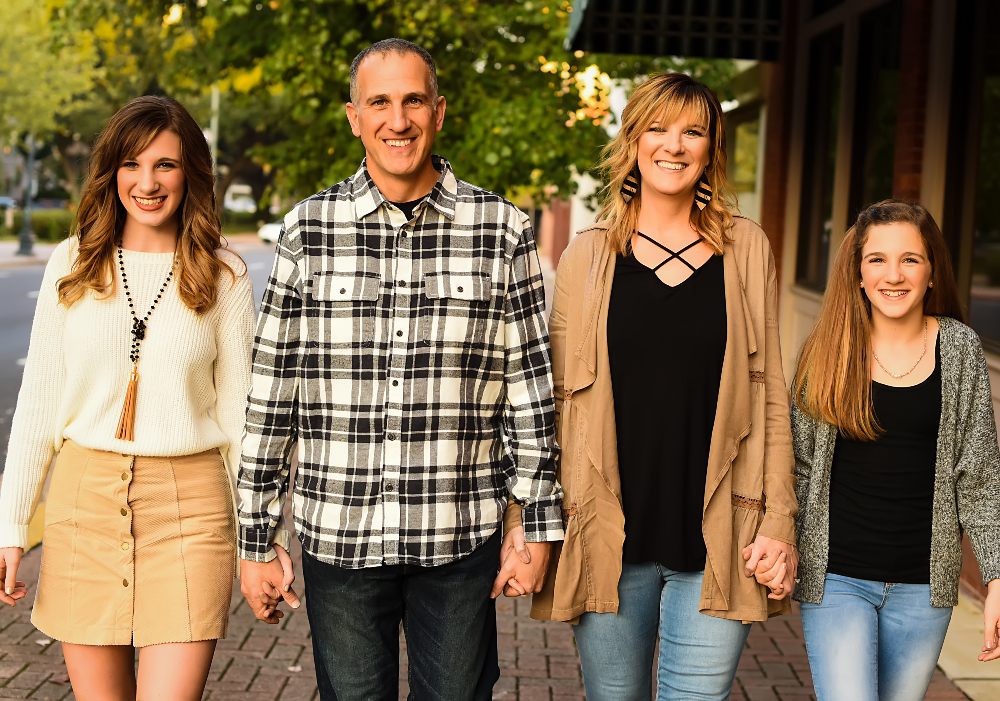
Born and raised in the South, I grew up on potluck dinners, Little Debbie snack cakes, milk and of course, sweet tea. Every family get-together was centered with a big piece of meat with cheesy sides and dairy-filled desserts. This is what I knew, so this is what I did when it was time for me to raise a family of my own.
I just turned 40 years old, and my husband David and I have been married for 19 years. We have two daughters, Taylor, 15, and Hilary who is (almost) 12. Through the years, I have gone through phases of “trying” to eat healthy and be a good example for my kids. If I listed all of the diet food programs, trainers, and fitness videos I have tried, you would nod off to sleep from boredom. Some of them were more successful than others until that inevitable “cheat day” would come around and then, bam! I went right back to my old habits. As you can see, the struggle for our family to find health was real.
A little over two years ago, my father was diagnosed with Multiple Myeloma with Amyloidosis. He lived six months after his diagnosis and died at a young age of sixty. Six months after his death, my father-in-law was diagnosed with lung cancer (and I might add he never smoked a day in his life). When it was found, the cancer had already spread to his bones and brain, and he died within two months of his diagnosis. Needless to say, the loss of two very important men in my life caused me to have a breakdown. I remember this feeling so well; it was two nights after my father-in-law’s funeral when my husband and I were in bed about to watch a show on television. I looked over at him and said, “I can’t lose you, too!”
It was that moment that changed our lives forever. What I haven’t told you yet is that my husband was diagnosed in 2007 with the kidney disease IgA Nephropathy (or Berger’s disease) after a routine physical for life insurance. At this time, it was being controlled with medications. He had asked doctors in the past if a special diet would be beneficial to his kidneys but was never really encouraged to do anything other than stay on the medications, use fish oil, and return for annual office visits. During my breakdown, this kidney disease finally became real to me when we learned that animal protein is terrible on your kidneys. So, we decided to make some big changes in our family.
We took a step back and started thinking of all the commonalities linked to the diseases in our families and realized that one factor that we could do something about was the food we put into our bodies. We watched several documentaries, read articles and books and decided that we wanted to heal our bodies and get our family healthy by adopting a Whole Food Plant Based lifestyle in our home. Luckily for us, a friend sent us a link to the Engine 2: Seven Day Rescue Challenge, and we started this in our home on January 2, 2017. A little joke we like to say in our home is that we went “cold turkey.” We were all in, dropping all animal products instantly, and have never looked back.
We sat our kids down to educate them on what we were discovering about the healing power of food and the changes that were being made in our home. I will let you imagine for yourself how that conversation went over with 11- and 14- year old girls. We did not ease them into this transition; remember, we went “cold turkey.” One day our pantry was filled with processed junk food, and the next day only plants. Our girls were in shock, but as we explained our reasoning behind these changes, they began to understand. After all, they had just lost both of their grandfathers, too. Kids are smarter than we like to give them credit for and can adapt when the changes are modeled for them.
A little over a year of plant-based living for our family and our kids are doing great. They are not perfect, and we do not make them resist cake and pizza at parties or junk food at a friend’s house. But when they are in our home, they eat what we eat. I am very proud of them. They get picked on at school and hear the same questions we adults hear. “Where do you get your protein?” And, “How will your bones stay strong without milk?” They have learned responses to these questions and have become more confident in the healthy changes in our family. They even surprise us sometimes and order a vegan option at a restaurant (on their own without our prompting). If our girls can do it, your kids can, too. I have included a few tips that have helped us during this transition.
6 Tips to Help Your Kids Go Plant-Based:
Be a good example and model the behavior you want to see in them both in and outside the home.
Include them in the process. Take turns choosing new recipes to try and then, take a trip to the store together to pick out the ingredients.
Have them help in the kitchen. We meal prep together on Sunday evenings. Make it a family affair. (My girls are dancers, so prepping is usually followed by a little dancing.)
Make all of their favorite meals; just adjust the ingredients to make them fit your new eating style.
Keep it simple. Don’t attempt to tackle recipes with tons of ingredients. This makes it complicated for you and them.
Help them understand what the healthy foods they are eating are doing for their bodies. Teens, especially, are generally concerned about their weight, skin and hair. Share with them the foods that are linked to good health in those areas.
Our lives have changed forever! My husband and I feel better than we have in years. He has cut his medications in half, his seasonal allergies have cleared up tremendously and he has lost 30 pounds. I have clear skin, my digestive issues are gone and I have lost over 40 pounds…that is a huge added BONUS! In just one year, we lost a total of 70 pounds in our home (which is equivalent to 300 sticks of butter). The only regret I have about this new lifestyle is that I didn’t know about it sooner. Many days I find myself wondering: If I had known what I know now, could I have helped my dad or father-in law? I won’t ever know the answer to that question, but since this change, I have committed to teaching others how to get on the journey to health by eating a Whole Food Plant Based diet.
I reached out to Jennifer Singh, MD, an Internist in the area, and told her about my passion to teach people what I have just recently discovered on my own. With her encouragement and help, I have put together a 6-week informational class with the things we have learned this year. My husband and I taught our first Life Group Class on Whole Food Plant Based eating and had 15 members. One of my favorite parts of this class is helping people connect with other people who have the same goal in mind. Everyone needs a tribe, and a WFPB tribe is extremely important as you begin this journey. Our first group was a success, and most of them have fully immersed into this way of life! We will continue to host the Life Group classes in our home during the spring semester. In addition, several of our closest friends and family members, seeing our example, are transitioning as well.
When you find that “magic” formula to a healthy family, you just want to tell everyone about it. Now that I know the benefits of plants and how your health can be guided by the foods you eat, I don’t want to sit back and watch as the standard American diet (SAD) takes the lives of more of my friends and family. I am currently in the application process to be certified to teach the Food for Life Program offered by Physicians Committee for Responsible Medicine. This certification will help me teach this life changing information in schools and clinics in Louisiana. My goal is that through education and example, we can help others go “cold turkey” and change the Southern view of food in our homes.

